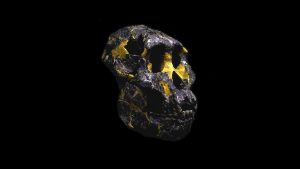
The first specimens attributed to Australopithecus afarensis were discovered in the early 1970s by researchers working in the Afar region of Ethiopia at the site known as Hadar. A succession of spectacular discoveries, including a knee joint in 1973, the famous Lucy skeleton in 1974, and the remains of a family group representing more than 17 individuals ensured that Au. afarensis would come to occupy a prominent place on the hominin family tree.
In addition to the impressive finds located by Donald Johanson and an international team of scientists, further amazing discoveries were uncovered by Mary Leakey and her team, a few years later and far to the south of Ethiopia, at the site of Laetoli, on the edge of the Serengeti Plains in Tanzania. Leakey’s team discovered trace fossils of footprints of hundreds of animals, preserved in an ash layer that was securely dated to 3.6 million years ago. Amongst the animal footprints were some 70-plus footprints of hominins, captured as they walked bipedally across a wet, muddy plain.
The remains from all sites attributed to Au. afarensis have been dated to between 3.9 and 3.0 million years. Paleoanthropologists working in Ethiopia, Kenya, and Tanzania over the last 40 years have recovered hundreds of specimens of Au. afarensis, including fossils from adult and juvenile males and females. These specimens have been invaluable for telling us about the differences between males and females and for giving insight into how Au. afarensis individuals changed as they aged. Some of this information is coming from spectacular recent discoveries from Dikika and Woranso-Mille in Ethiopia. Dikika is located across the river from Hadar, and the relatively complete skeleton of a three-year-old female nicknamed “Selam” was found at this site. Another partial skeleton of a large adult individual of Au. afarensis, nicknamed “Kadanuumuu,” was also recovered from Korsi Dora, a locality in the Woranso-Mille site.
The skull of Au. afarensis is characterized by a prognathic (projecting) face and a relatively small brain. Brain size estimates range from 380-550 cc, which is somewhat larger than the average contemporary chimpanzee. The jaw muscles were quite large, as evidenced by the large crests on the skull. There is pronounced sexual dimorphism in the skull and post crania of this species; thus males were larger than females and had larger canine teeth as well.
There is a wealth of postcranial bones belonging to this species, including the partial skeleton of Lucy, officially designated A.L. 288-1. Au. afarensis certainly was bipedal (walked fully upright on two legs), but there has been considerable debate among researchers on exactly how this species walked. The Laetoli footprints, the shape of the pelvis, the curvature of the vertebral column, and the anatomy of the knee all indicate Au. afarensis walked on two legs. However, there are many differences in anatomy between this taxon and modern humans, which have led some paleoanthropologists to argue that Au. afarensis incorporated some degree of arboreal climbing into its locomotor repertoire and its stride, or gait, was not like ours. These differences include proportionally short legs and longer arms; long, curved finger and toe bones; and subtle differences in the bones of the hip.
The earliest stone tools were reported from a site called Gona in Ethiopia in 1994. Radiometric dating gave an age of 2.6 million years; but no hominin remains were found in the same context, and it could not be known which of the several hominin species extant at the time was the maker. More than thirty years earlier, stone tools had been discovered at Olduvai Gorge where remains of several species of Australopithecus and Homo, dated to around two million years ago, were plentiful. Whether a late australopithecine or an early Homo made these tools could not be stated with certainty, but researchers have generally assumed the slightly larger brain size of early Homo placed the maker in that lineage rather than the slightly smaller brained Australopithecus.
These assumptions were challenged by the 2009 discovery of two small pieces of bone with possible stone tool marks. One bone was from an antelope-sized animal and the other from a bovid the size of a modern cow. The bones were found at Dikika, Ethiopia, within the securely dated Sidi Hakoma formation and given an age of 3.4 million years. By process of elimination, trampling of the bones underfoot by animals, toothmarks, or having been tumbled in a stream were ruled out, and the only explanation for the markings appears to be the use of stone to scrape flesh from the bones and striking one of the bones to fracture it and extract the marrow. Australopithecus afarensis is the only hominin taxon known to be present in this area between 3.4 and 3.0 million years ago, making the species a candidate for the first users of stone tools.
It is important to keep in mind the distinction between making and using stone tools. No stones fashioned during this period for use as implements have been found at Dikika or Hadar. The most likely explanation is that whoever was defleshing these bones used a naturally shaped stone lying nearby. It cannot be said with certainty that Australopithecus afarensis were fashioning stone for particular uses more than three million years ago. Shaping stone to produce a point or cutting edge seems to have been developed later.